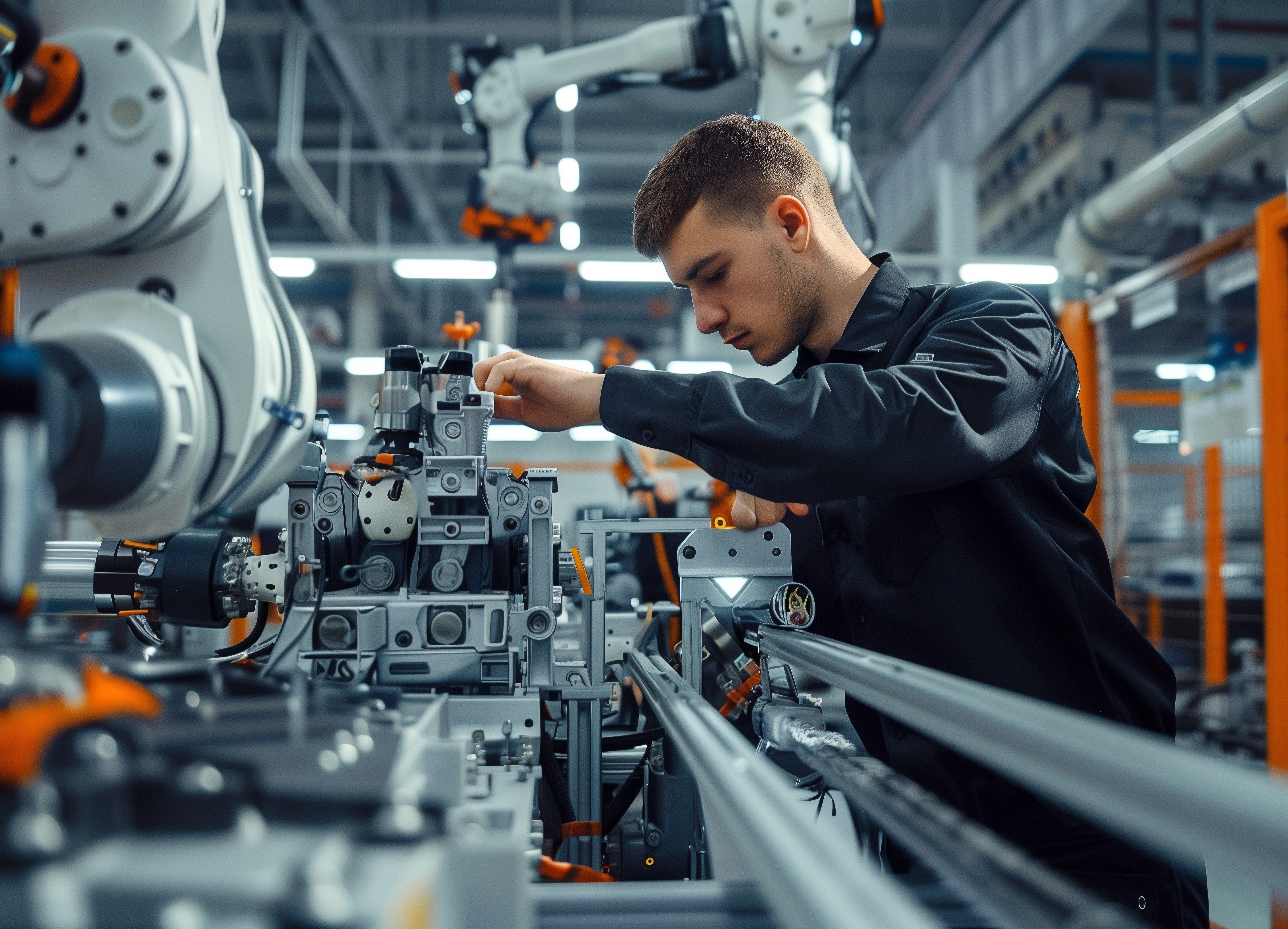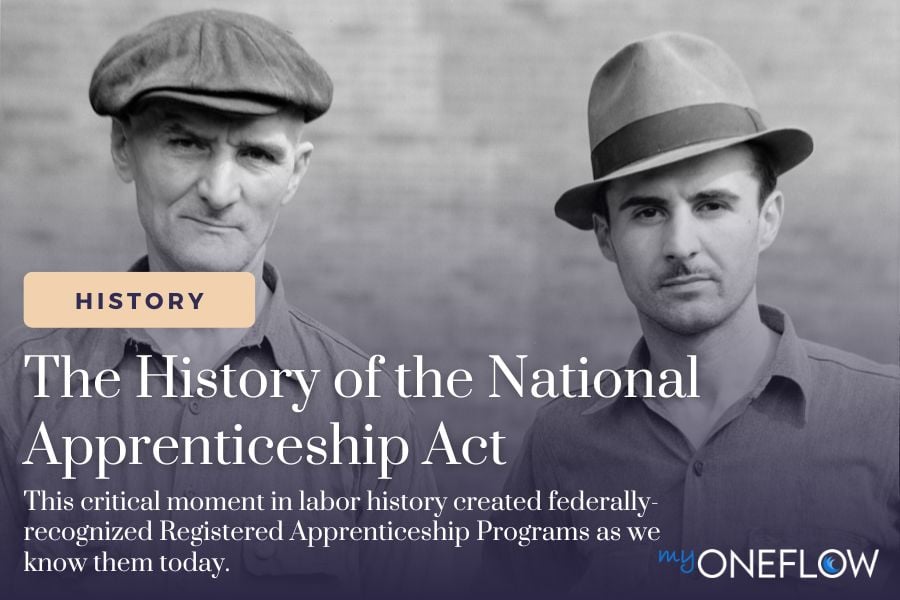How An Apprenticeship Can Help Your Business Combat the Labor Shortage
Since the pandemic, businesses have been facing an unprecedented labor shortage. As of June 2022, there were almost twice as many job openings as...
4 min read
myOneFlow Staff Apr 25, 2025 1:03:20 PM

Apprenticeships have long been vital for workforce development, providing individuals with hands-on experience while addressing critical labor shortages. However, as economic landscapes shift and industries evolve, the need to reimagine these programs has never been more apparent. President Donald J. Trump’s recent executive order on workforce development seeks to modernize the apprenticeship model for the demands of a 21st-century economy. But what does it actually mean to modernize apprenticeships? Or any workforce development initiative, for that matter? In this blog, we'll dive into the evolution of apprenticeships, examining their historical legacy, current federal and state-level initiatives, and what must be done to ensure they meet the ambitious goals of today’s government and the workforce needs of tomorrow.
On April 23, 2025, President Donald J. Trump signed an executive order aimed at modernizing American workforce programs. This initiative directs the Departments of Labor, Education, and Commerce to develop strategies for integrating and aligning existing systems, with a strong emphasis on apprenticeship expansion. The order highlights key workforce challenges, including an annual shortage of nearly half a million skilled tradespeople, and sets an ambitious target of preparing one million apprentices annually. Central to this effort is the idea of reshoring manufacturing jobs and capitalizing on advancements in artificial intelligence. By focusing on practical skills through apprenticeship programs, the executive order aims to equip Americans with the tools needed to sustain U.S. economic leadership while addressing pressing workforce needs in high-demand sectors. The President's call to "modernize!" joins the chatter of policymakers, service providers, and citizens who have been calling for the same. While the conversation around modernization is certainly energized, turning vision into action will require careful planning, concrete steps, and a commitment to overcoming obstacles.
Modernizing apprenticeships involves more than updating training curricula or increasing program enrollment. It requires rethinking how these programs operate, integrate, and deliver value in an era of technological and social change. Apprenticeships must retain their fundamental strengths, such as hands-on learning and mentorship, while incorporating new tools like digital platforms, real-time data sharing, and virtual training to reach a broader audience and increase accessibility. However, the implementation of modernization faces several complexities. Integrating innovative technologies and expanding capacity demands significant investment, cross-sector collaboration, and a commitment to program inclusivity. To understand what’s at stake, it’s important to first consider the historical challenges and successes of apprenticeships in the U.S.
Apprenticeships have a long history in the U.S., historically centered on skilled trades such as construction and manufacturing. These programs provided reliable pathways to employment in well-compensated careers. Over time, apprenticeships have expanded into non-traditional sectors, such as healthcare, IT, and finance, signaling their adaptability to evolving labor market demands.
Despite these successes, apprenticeships have faced ongoing challenges:
President Trump’s executive order highlights the federal government’s commitment to expanding and strengthening apprenticeship programs. Measures include refocusing investments on career preparation over traditional college pathways and prioritizing emerging industries such as AI, advanced manufacturing, and green energy. The administration hopes to address workforce shortages by redirecting attention to hands-on skill-building while creating pathways to high-quality jobs.
At the state level, innovative approaches complement federal goals, as highlighted by the National Governors Association (NGA). States have increasingly embraced apprenticeships in high-demand fields such as healthcare, IT, and advanced manufacturing. Initiatives such as registered youth apprenticeships and targeted training programs have enrolled tens of thousands of participants, showing the potential for scalability and long-term impact. States are also exploring the use of AI and digital tools to enhance workforce service delivery. For example, online career exploration platforms, apprenticeship case management systems, and real-time job-matching tools are reshaping how states support both workers and employers. Importantly, many state programs offer supportive services, such as childcare, transportation, and housing assistance, which help break down barriers that have historically prevented individuals from completing workforce programs. NGA also notes that strategic adjustments to workforce governance and accountability frameworks are helping align these programs with education systems and labor market needs. Taken together, federal and state efforts demonstrate how modernization can be a collaborative success story—but realizing the full potential of these programs will require bold action on multiple fronts.
Modernizing apprenticeships is an ambitious goal that will require a coordinated effort from policymakers, educators, and industry leaders. Success depends on tackling key challenges head-on and reimagining traditional systems at every level.
Capacity bottlenecks must be addressed to meet the government’s target of one million apprentices a year. Strategies could include equipping mentors to train multiple apprentices simultaneously and increasing investment in staff training and program infrastructure.
Digital platforms, real-time data sharing, and AI-powered tools can revolutionize the delivery of apprenticeships. Virtual and hybrid training models can expand access for rural communities and individuals with limited schedules, offering a flexible approach to workforce development and career training.
Apprenticeship programs must actively engage underrepresented groups, including women, minorities, and veterans, to ensure equitable representation and opportunities. Subsidies, outreach, and supportive services, such as childcare and housing, can mitigate barriers to participation while increasing diversity in the skilled labor pipeline.
Programs must be designed in partnership with local and regional industries to ensure training reflects labor market demands. Integrating career pathways into high schools and colleges can provide younger generations with a seamless route to apprenticeship opportunities.
Robust metrics to track outcomes, from enrollment to post-program employment, will be essential for evaluating success and guiding future improvements. Both public and private stakeholders must remain committed to ensuring programs deliver tangible value to participants and employers.
Reimagining apprenticeship programs is an economic necessity. A future-ready workforce is essential for maintaining U.S. competitiveness, addressing skilled labor shortages, and promoting economic mobility. However, achieving the vision of an effective, inclusive, and scalable apprenticeship system will require bold leadership, innovative solutions, and a shared commitment to progress. By rethinking how apprenticeships operate and adapting to the realities of the modern economy, the United States can truly reimagine apprenticeship to build the skilled workforce of tomorrow.
myOneFlow is helping apprenticeship and workforce programs nationwide modernize their operations with a configurable, scalable platform for case management and reporting. Compare our package offerings to learn more about how we can support your program.

Since the pandemic, businesses have been facing an unprecedented labor shortage. As of June 2022, there were almost twice as many job openings as...


The history of apprenticeships in America is as old as the nation itself. British artisans and tradespeople came to the colonies to help build and...